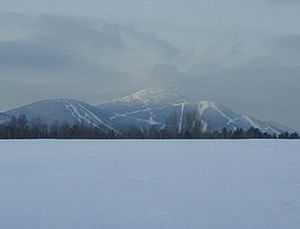Jay Peak Resort facts for kids
Quick facts for kids Jay Peak Resort |
|
|---|---|
| Location | Jay, Vermont |
| Nearest city | Jay, Vermont |
| Coordinates | 44°55′46″N 72°31′56″W / 44.92944°N 72.53222°W |
| Vertical | 2,153 feet (656 m) |
| Top elevation | 3,858 feet (1,176 m) |
| Base elevation | 1,843 feet (562 m) |
| Skiable area | 385 acres (1.56 km2) |
| Runs | 76 |
| Longest run | 4.828 kilometres (3.000 mi) |
| Lift system | 8 (1 Aerial tramway, 5 chairs, 2 surface lifts) |
| Snowfall | 355 inches (901.70 cm)29.6 feet (9.02 m) |
Jay Peak Resort is a popular ski resort in the United States. It's located on Jay Peak in the Green Mountains of Vermont. The resort is known for its amazing skiing and snowboarding. It has a vertical drop of 2,153 feet (656 m). This makes it one of the biggest ski areas in New England.
Jay Peak is very close to the Canada–United States border. It's only about 4 miles (6.5 km) south of Quebec, Canada. The resort first opened for skiing in 1957. Today, it offers fun activities all year round. It has 78 trails and nine lifts. Jay Peak gets more snow than any other ski area in the Northeastern U.S.
In 2016, the resort faced some challenges. It was put under special management by the U.S. government. But don't worry, the resort stayed open and still welcomes visitors!
A Look at Jay Peak's History
The ski trails at Jay Peak were first made in the 1950s. Walter Foeger, an Austrian ski expert, helped design them. He was the resort's first ski school director. Walter Foeger taught a special way to ski called "Natur Teknik." This method helped people learn to ski parallel turns quickly. The Jay Peak ski school even promised you could "learn to ski in a week!"
The resort's first ski lift, a T-bar, was bought in 1955. Jay Peak officially opened for skiing in January 1957. Over the years, the resort grew. A hotel was built in the mid-1970s. In 1978, a company called Mont Saint-Sauveur International bought the resort.
By 2006, Jay Peak employed many people. It had 550 workers in the winter and 100 in the summer. The resort became a very important employer in the area. In 2008, a new group led by Bill Stenger bought Jay Peak. They planned to make many improvements to the resort.
In 2010, Jay Peak made big upgrades. They added an indoor ice arena and a parking garage. A new ticketing system using RFID was also put in place. The old hotel was replaced with a new one that has 170 rooms. New facilities also included a spa and a huge 33,000 square feet (3,066 m2) water park.
Yankee magazine even named Jay Peak the best ski resort in New England in 2010!
Ski Trails and Lifts
As of 2013, Jay Peak has 78 ski trails. These trails cover almost 385 acres (156 ha) of skiable land. About 100 acres are "Glades," which are special areas for skiing through trees. Jay Peak is famous for its "Face Chutes." These are some of the steepest and most challenging ski runs in the eastern U.S. They are very narrow and even have a mandatory cliff drop!
Jay Peak has eight different lifts to take skiers up the mountain. These include one aerial tramway, three quad chairlifts, one triple chairlift, one double chairlift, and two magic carpets. Together, these lifts can carry about 12,000 skiers per hour!
The oldest lift is the 60-person aerial tramway. It's often called the "tram." This tram is the only one of its kind in Vermont! It was first built in 1966. In 2016, the tram got major safety upgrades. Its capacity was changed to 45 people per car.
To get on the lifts, skiers use an RFID system. This system scans a special chip in a plastic card. You usually keep this card in your pocket.
Lots of Snow!
Jay Peak is known for getting a lot of snow. The top of the mountain is at 3,858 feet (1,176 m) high. Jay Peak gets the most average annual snowfall of any ski area in Eastern North America. It gets about 355 inches (9 metres) of snow each year!
For example, in the 2000-2001 winter, the resort reported an amazing 513 inches (1,303 cm) of snowfall. Between 2008 and 2014, the resort averaged 332.5 inches (27.71 ft; 8.45 m) of snow every winter. This makes for great skiing conditions!
Other Fun Stuff to Do
Jay Peak Resort has more than just skiing. There are two main buildings at the bottom of the mountain. There's also a small lodge at the very top, where the tram stops. You can find hotels and many condominium units where you can ski right to your door!
The resort also has a full-sized hockey rink called the Ice Haus. It can hold up to 700 people watching a game. Right next to it is a large parking garage.
In 2011, an indoor water park opened called The Pump House. It's a super fun place to visit! It has the longest "lazy river" in all of Vermont.



